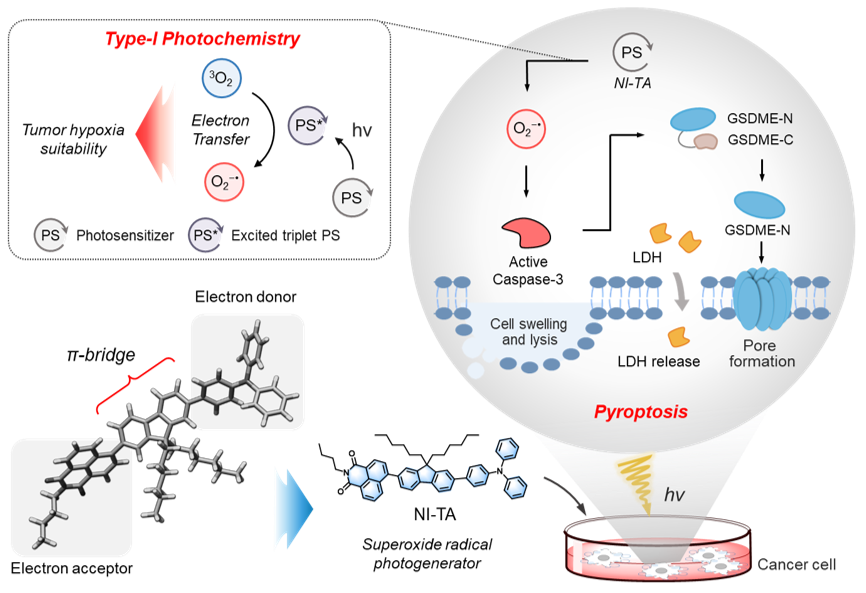Photocatalytic Superoxide Radical Generator that Induces Pytoptosis in Cancer Cells
| author | Jong Seung Kim |
|---|---|
| Homepage | http://orgchem.korea.ac.kr/ |
| journal | Journal of the American Chemical Society |
In this study, we show that a photocatalytic superoxide radical (O2−•) generator, NI-TA, triggers pyroptosis in cancer cells. NI-TA was designed to take advantage of an intramolecular triplet-ground state splitting energy modulation approach. Detailed studies revealed that the pyroptosis triggered by NI-TA under conditions of photoexcitation proceeds through a caspase-3/gasdermin E (GSDME) pathway rather than via canonical processes involving caspase-1/gasdermin-D (GSDMD). NI-TA was found to function via a partial-O2-recycling mode of action and to trigger cell pyroptosis and provide for effective cancer cell ablation even under conditions of hypoxia (≤2% O2). In the case of T47D 3D multicellular spheroids, good antitumor efficiency and stemness inhibition are achieved. This work highlights how photocatalytic chemistry may be leveraged to develop effective pyroptosis-inducing agents.

https://doi.org/10.1021/jacs.2c03256
« Prev Deep learning for development of organic optoelectronic devic...
 Deep learning for development of organic optoelectronic devic...
2023.05.08by webmaster2
〈
Deep learning for development of organic optoelectronic devic...
2023.05.08by webmaster2
〈
Direct C-H metallation of tetrahydrofuran and application in ... Next »
 Direct C-H metallation of tetrahydrofuran and application in ...
2023.05.08by webmaster2
〉
Direct C-H metallation of tetrahydrofuran and application in ...
2023.05.08by webmaster2
〉
Articles
- Self-Aggregating Tau Fragments Recapitulate Pathologic Phenotypes and Neurotoxici...
-
 Ultranarrow Mid-infrared Quantum Plasmon Resonance of Self-Doped Silver Selenide ...
Ultranarrow Mid-infrared Quantum Plasmon Resonance of Self-Doped Silver Selenide ...
-
 Molecular Thermoelectricity in EGaIn-Based Molecular Junctions
Molecular Thermoelectricity in EGaIn-Based Molecular Junctions
-
 Perovskite Nanocatalsts Protected by Hermetically Sealing for Highly Bright and S...
Perovskite Nanocatalsts Protected by Hermetically Sealing for Highly Bright and S...
-
 The importance of a charge transfer descriptor for screening potential CO2 reduct...
The importance of a charge transfer descriptor for screening potential CO2 reduct...
-
 Resonant Raman-Active Polymer Dot Barcodes for Multiplex Cell Mapping
Resonant Raman-Active Polymer Dot Barcodes for Multiplex Cell Mapping
-
 Decoding the Roles of Amyloid-β (1-42)'s Key Oligomerization Domains toward Desig...
Decoding the Roles of Amyloid-β (1-42)'s Key Oligomerization Domains toward Desig...
-
 Flattening bent Janus nanodiscs expands lattice parameters
Flattening bent Janus nanodiscs expands lattice parameters
-
 Directing the surface atomic geometry on copper sulfide for enhanced electrochemi...
Directing the surface atomic geometry on copper sulfide for enhanced electrochemi...
-
 High Seebeck Coefficient Achieved by Multinuclear Organometallic Molecular Junctions
High Seebeck Coefficient Achieved by Multinuclear Organometallic Molecular Junctions
-
 Thermopower in Transition from Tunneling to Hopping
Thermopower in Transition from Tunneling to Hopping
-
 An Activity-Based Fluorescent Probe for Imaging Fluctuations of Peroxynitrite (ON...
An Activity-Based Fluorescent Probe for Imaging Fluctuations of Peroxynitrite (ON...
-
 Deep learning for development of organic optoelectronic devices: Efficient prescr...
Deep learning for development of organic optoelectronic devices: Efficient prescr...
-
 Photocatalytic Superoxide Radical Generator that Induces Pytoptosis in Cancer Cells
Photocatalytic Superoxide Radical Generator that Induces Pytoptosis in Cancer Cells
-
 Direct C-H metallation of tetrahydrofuran and application in flow
Direct C-H metallation of tetrahydrofuran and application in flow
-
 Functionalization of Diamine-Appended MOF-Based Adsorbents by Ring Opening of Epo...
Functionalization of Diamine-Appended MOF-Based Adsorbents by Ring Opening of Epo...
-
 High Gravimetric and Volumetric Ammonia Capacities in Robust Metal-Organic Framew...
High Gravimetric and Volumetric Ammonia Capacities in Robust Metal-Organic Framew...
-
 Li-ion Intercalation, Rectification, and Solid Electrolyte Interphase in Molecula...
Li-ion Intercalation, Rectification, and Solid Electrolyte Interphase in Molecula...
-
 Thermopower of Molecular Junction in Harsh Thermal Environments
Thermopower of Molecular Junction in Harsh Thermal Environments
-
 Microfluidics-Assisted Synthesis of Hierarchical Cu2O Nanocrystal as C2-Selective...
Microfluidics-Assisted Synthesis of Hierarchical Cu2O Nanocrystal as C2-Selective...
Designed by sketchbooks.co.kr / sketchbook5 board skin